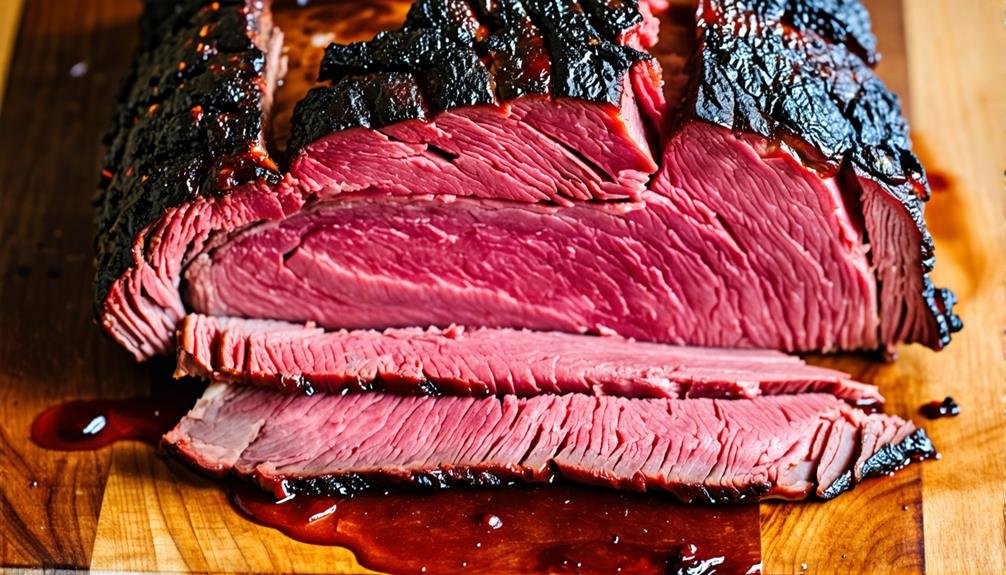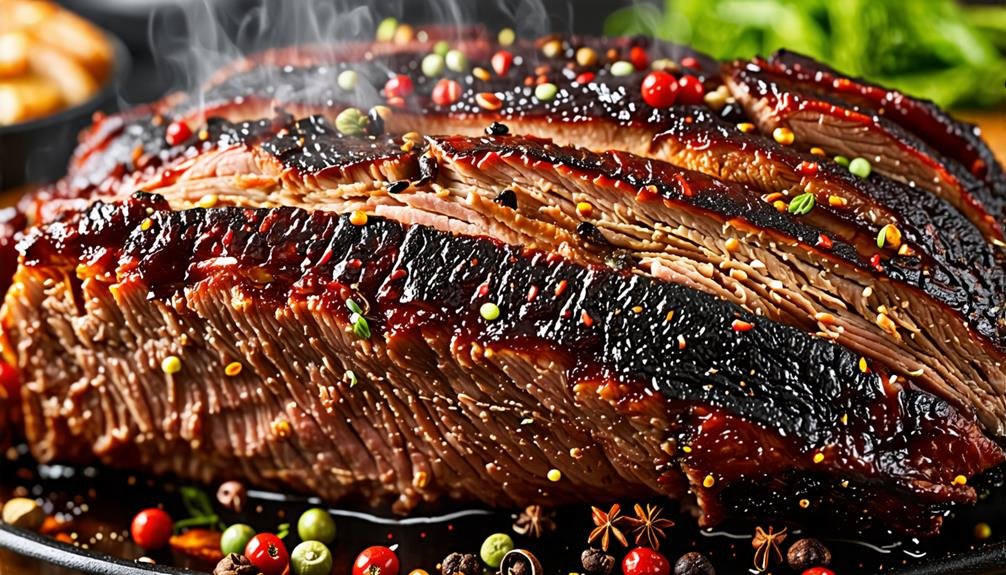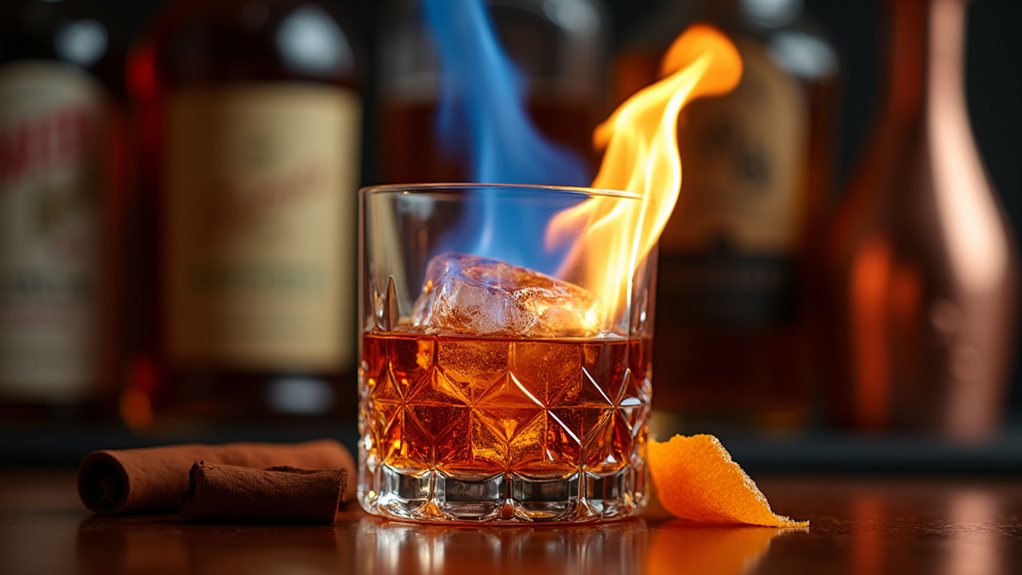Cooked smoked meat can appear raw due to the presence of myoglobin, a protein that retains a reddish hue even after cooking. When smoked, nitrogen dioxide is introduced, which hinders the oxidation process, leading to a pink color that mimics raw meat. This is particularly evident in the formation of smoke rings, a prized visual feature among barbecue enthusiasts. However, these rings do not indicate taste or doneness. Instead, using a meat thermometer is crucial to guarantee food safety. Understanding these reactions not only heightens appreciation for smoked meats but also elevates your culinary skills in the kitchen.
Understanding Cooked Meat Appearance
Understanding the appearance of cooked meat, especially smoked options like brisket or ribs, involves recognizing the influence of myoglobin and chemical reactions that alter its color. Smoked meat often retains a raw-like look due to myoglobin, a protein responsible for the meat's vibrant hues. In its raw state, meat shows a purplish tint; however, as it cooks, myoglobin changes, resulting in the characteristic pinkish tones seen in smoked varieties.
Additionally, the smoking process introduces nitrogen dioxide (NO2), which interacts with myoglobin, preventing complete oxidation. This reaction creates a striking visual contrast that can confuse untrained observers. Grasping these culinary explanations allows enthusiasts to appreciate the science behind their creations. While the appearance may raise questions, the flavor and safety of cooked smoked meat, such as those from brands like Traeger or Weber, remain paramount. Therefore, the next time you encounter beautifully smoked meat that appears undercooked, celebrate the artistry and science behind it, knowing that deliciousness lies beneath that intriguing exterior!
The Science of Smoke Rings
The vivid pink ring often seen in barbecue is an intriguing result of the interaction between myoglobin and nitrogen dioxide during the smoking technique. Myoglobin, a color-providing protein in meat, contains heme pigment that reacts in a special way during smoking. When the meat encounters nitrogen dioxide (NO2), primarily produced from burning hickory or mesquite wood chips, a rosy coloration develops, forming the signature smoke ring.
Here are some essential points to remember:
- Myoglobin Behavior: Myoglobin shifts from a purplish hue to red upon oxygen exposure, but nitrogen dioxide hampers this change, resulting in the pink ring.
- Chemical Reaction: The union of nitrogen dioxide with myoglobin is a chemical interaction, without any impact on taste.
- Visual Indicator: Although the smoke ring is a pleasing visual element, it does not assure the meat's taste or proper cooking.
Grasping the science behind smoke rings deepens our appreciation for barbecued meat, encouraging us to explore the craft of smoking with eagerness and wonder.
Impact of Smoke Rings on Taste

Smoke rings, while visually striking, do not enhance the flavor of smoked meats. These appealing pink bands act mainly as a visual sign, indicating that the meat has been prepared in a smoker. It's important to understand that the nitrogen dioxide (NO2), which creates the smoke ring, is devoid of taste. Therefore, the existence of a smoke ring does not imply an increase in flavor.
One may admire the craftsmanship of a perfectly smoked brisket, but that rosy ring does not ensure an exquisite bite. Flavor depends on various elements, including the wood type, seasoning choices, and cooking duration. While the smoke ring can be a point of pride for barbecue enthusiasts, it merely signifies the smoking method rather than a guarantee of taste.
In the end, culinary exploration allows one to appreciate smoked meats for their rich and complex flavors, independent of their appearance. So, while you may take satisfaction in achieving that sought-after smoke ring, remember that genuine flavor emerges from the core of the cooking process, not just the exterior. Embrace the journey of flavor discovery!
Recommended Cooking Practices
Achieving perfectly smoked brisket requires careful attention to cooking methods, including the use of a digital meat thermometer to ensure proper doneness. Cooking smoked ribs is as much an art as it is a science. While the enticing aroma and visual appeal of smoked pork can be tempting, it's essential to focus on accuracy for the best outcomes.
- Invest in a reliable ThermoPro meat thermometer: This tool is your best ally for ensuring that your brisket reaches the ideal internal temperature.
- Master your wood chip smoker's cooking times: Understanding the intricacies of your Traeger smoker will help you gauge the perfect cooking duration.
- Enhance flavor with homemade marinades: A good marinade can enhance your dish, adding depth and richness to the overall flavor of your smoked chicken.
Common Misconceptions About Smoke Rings

Many enthusiasts mistakenly believe that a smoke ring is a definitive sign of flavorful smoked meat, but this is far from the truth. While the pink ring does indicate a chemical reaction involving nitrogen dioxide and myoglobin, it does not guarantee an improved taste or texture. Understanding the distinction between appearance and flavor can boost your smoking skills and make sure that your meat is both visually appealing and delicious.
Smoke Ring Misunderstandings
The appearance of a smoke ring is frequently misinterpreted as a clear sign of meat's flavor and quality, resulting in inaccuracies about its role in the smoking method. Although it is certainly an appealing visual aspect that many barbecue chefs appreciate, the smoke ring does not guarantee enhanced taste or texture. Grasping the science behind it can help dispel these inaccuracies.
- Aesthetic Quality: A smoke ring is a striking characteristic that many grill masters admire.
- Taste Misconceptions: The chemical process that forms the smoke ring does not enhance flavor.
- Cooking Facts: An impressive smoke ring does not confirm that your meat is fully cooked.
These misunderstandings can cloud perceptions and promote reliance on visuals instead of effective cooking methods. Accepting the smoke ring as a bonus rather than a standard allows for a more enjoyable and liberated smoking journey. Therefore, while you may delight in the sight of that rosy ring, remember that flavor and quality ultimately stem from meticulous cooking practices, not merely striking appearances.
Taste Vs. Appearance
While the visual charm of a smoke ring often draws in barbecue enthusiasts, it is essential to recognize that its presence does not indicate the flavor or quality of smoked meats like brisket or ribs. Many pitmasters mistakenly believe that a prominent smoke ring signifies a better taste. However, the reality is that the smoke ring, a pinkish tint formed by nitrogen dioxide reacting with myoglobin in the meat, contributes nothing to flavor enhancement.
Instead, this visual cue simply signifies that the meat has undergone smoking in a barbecue setup. It serves as a badge of honor for barbecue chefs but does not influence the overall culinary experience. The true flavor comes from the blend of spices, marinades, and the actual cooking process—elements that transcend those appealing pink layers.
To genuinely savor the deliciousness of smoked meats, concentrate on cooking methods and flavor profiles rather than just the visuals. Relying solely on the smoke ring to judge quality can lead to dissatisfaction. So, embrace the opportunity to explore flavors beyond appearances, and remember: the real magic lies in the taste, not merely the look of your smoked creations.
Chemical Reaction Explained
A common myth surrounding smoke rings is that their existence guarantees enhanced flavor in smoked meats. In reality, smoke rings arise from a specific chemical interaction between nitrogen dioxide and myoglobin. This appealing pink color primarily reflects the science behind the smoking process rather than taste.
When meats like brisket or pork ribs are smoked, nitrogen dioxide (NO2) engages with myoglobin, the protein that gives meat its coloration. This chemical reaction produces a pink ring, serving as a visual signal that the meat has undergone smoking. However, it does not contribute to flavor. Here are some crucial points to remember:
- Smoke rings act solely as a visual indicator, not a flavor enhancer.
- Nitrogen dioxide is flavorless and does not affect taste.
- The presence of a smoke ring does not ensure that the meat is cooked thoroughly.
Significance of Smoke Rings
Smoke rings represent a visual tribute to the art of barbecuing, celebrated by barbecue masters as a marker of expertise rather than a gauge of taste. These alluring pink circles, commonly found in smoked meats, arise from a chemical interaction involving nitrogen dioxide. When hardwood chips combust, they emit this gas, which reacts with myoglobin in the meat, producing that signature rosy tint. Although the appearance of a smoke ring can inspire admiration and satisfaction, it's crucial to recognize that it does not enhance the flavor of the meat.
Barbecue chefs frequently strive for the ideal smoke ring, as it indicates a successful smoking process, reflecting their proficiency in the craft. Nonetheless, the existence of a smoke ring does not guarantee a delectable result. The essence of flavor resides in the thoughtful choice of ingredients, seasonings, and cooking methods. In the end, while smoke rings are a distinctive feature of smoked meat, they function more as a mark of achievement than a measure of palatability. So, as you appreciate the allure of your smoked dish, remember that the true joy lies in savoring each mouthful.
Ensuring Proper Meat Doneness

Ensuring proper meat doneness is essential for safety and enjoyment. Undercooked poultry can lead to health issues, while overcooked beef may lose its appealing texture and flavor. Achieving the ideal doneness enhances your culinary journey, allowing you to appreciate the diverse flavors and aromas of smoked brisket.
To ensure that your smoked meat reaches the perfect temperature, consider these tips:
- Use a digital meat thermometer: This tool provides the most accurate internal temperature, eliminating any guesswork.
- Pay attention to cooking times: Each cut, whether it's pork shoulder or chicken thigh, has an average cooking duration that can help guide your preparation.
- Trust your senses: Look for visual indicators, but also engage your sense of smell and feel, as these can also signal the meat's readiness.









